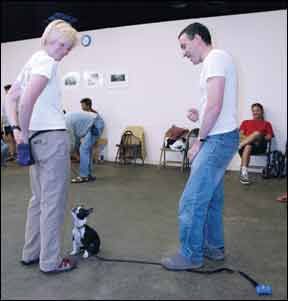Despite a lagging economy, the pet care industry continues to thrive, experiencing a steady increase for the past 17 years. According to the American Pet Products Association, we spent more than $50 billion on our animal friends in 2011. With an estimated 46 million American households owning at least one dog, many long-time dog lovers are considering a career partnership with man’s best friend.

288
Regardless of what inspires you to explore a career training dogs, it’s critically important to recognize that, above all, dog training is a profession. As such, there are many important considerations and obligations to be aware of.
Dog Training is People Training
Don’t let the “dog trainer” title fool you. I once heard Kathy Sdao, an associate certified animal behaviorist in Tacoma, Washington, joke about how, the next time she has business cards printed, she’ll replace the words “dog training” with “primate training.” Even when you think life has “gone to the dogs,” you’ll still find yourself logging a substantial number of hours engaged in the art of dealing with humans. In fact, interacting with people makes up the lion’s share of a career in dog training.
Dog training is a service-oriented profession; dog trainers work with people who happen to own dogs. Even trainers who specialize in board-and-train programs, where they work with a dog in the owner’s absence, must develop and maintain strong “people skills” in order to successfully communicate to the owner how to effectively maintain newly learned skills once the dog is back in the home.
If you’ve ever worked in a service industry, you know about the wide range of personality types that comprise the client pool. Some clients are friendly, attentive, and a joy to serve. Others are argumentative, cranky, and can make the art of good customer service seem just shy of impossible. Guess what? Those same personality types are often dog owners. As a dog trainer, you’re likely to encounter all types of clients: from the dedicated dog owner who is detailed and compliant, to the unorganized complainer who shows up late for lessons, doesn’t log necessary training hours, and still complains about his dog’s behavior.
We can’t stress this point enough. Most people are attracted to a career as a dog trainer because they like working with dogs, and quickly find the real work often lies in working with dog owners. On most days, a good dog trainer is part instructor, part coach and part problem-solver. Other days, being a dog trainer feels more like an ad-hoc relationship counselor as you sit with a couple arguing over who did more (or less) of the training that week; or a potential emergency worker as you do your best to politely yet firmly educate a new client on why the way to “fix” the issue of the dog growling at the toddler is not to help the toddler pin the dog to the ground.
By the time many people come to consult a professional trainer, they’re already frustrated with their dogs and near the end of their rope. They want behavior change and they want it yesterday. They’ve often already received bad advice by well-meaning friends and family that goes against how you believe dogs should be treated. The job of the trainer is to figure out how best to communicate with each client as an individual, in a way that allows the person to be receptive to your input. You might encounter situations where, in your head, all you can think is, “Are you nuts?!” but if you respond as such, even just out of your passion for dogs, you’ll likely alienate the client. If this happens, everybody loses – especially the dog. Trainer and author Ian Dunbar invites his dog training students, when they grow frustrated with a difficult client, to imagine a syringe full of euthanasia solution – the worst possible conclusion if a dog owner can’t achieve some satisfaction with the dog’s behavior. In the end, your ultimate success depends on your ability to motivate, inform, retain, and inspire people.
Learn Before You Earn
Dog training is an unregulated industry. Unlike becoming a lawyer or a doctor, anyone can decide to be a dog trainer, advertise herself as such, and begin accepting money for working with dogs.
“There’s not one obvious entry point into the profession,” says Veronica Boutelle of dog*tec, an Oregon-based consulting company for professional dog trainers. “It’s important to recognize that nobody will say you have to, but there’s an ethical obligation to become as educated about dogs, dog behavior, and training as possible.”

288
Loving dogs is not enough. “Our conventional wisdom about dogs is misleading in a number of ways,” explains Boutelle. “There are a whole lot of things we, as a society, think we know about dogs, that in reality, we have strangely backwards. Those misconceptions can get us into a lot of trouble when we start working with dogs professionally.”
Dogs communicate via often incredibly complex body language. To the average dog owner, a wagging tail always indicates a friendly dog; the dog who fails to run away when hugged by a child obviously enjoys the interaction; and the snappy little dog must have a Napoleon complex. The educated dog trainer likely sees a different picture by analyzing the rest of the dogs’ body language within various contexts.
In seeking an education, there are several routes to pursue. According to the Association of Pet Dog Trainers, most people employed as dog trainers are largely “self-educated” through extensive reading; attending seminars, workshops, and conventions; and, in many cases, mentoring with another trainer.
For students looking for a more structured academic approach, a handful of dog trainer schools exist, offering both online and in-person programs ranging from six days to six months and costing from $1,200 to more than $5,500. “Most dog trainers who are committed to professional, ethical dog training attend multiple schools in order to get a well-rounded education,” says Boutelle. “Serious dog trainers’ resumes are full of workshops and seminars; it’s an extremely extensive field.”
When researching schools and continuing education opportunities, it’s important to do your homework. We recommend limiting the list to schools that focus on scientifically sound, ethical, and humane training practices as opposed to programs that employ more “traditional” methods involving dominance, intimidation, and physical punishment.
Be cautious of school and programs promoting an ability to produce “certified” dog trainers. Regardless of what school you attend, earning a certificate is the program’s way of acknowledging that a student has successfully completed the fee-based program requirements. This is different from an independent assessment of the student’s general knowledge and ability as a trainer. Trainers seeking an independent certification can, upon meeting certain requirements, apply to test with the Certification Council for Professional Dog Trainers.
Experience Needed
“One of the biggest issues we’ve found, especially with the popularity of the Internet, is that people coming into the profession have a great deal of knowledge but, often, not a lot of mechanical skills,” says Mychelle Blake, executive director of the Association of Pet Dog Trainers. “I’ve seen a lot of people who have a business card and who call themselves trainers, but you hand them a strange dog in a workshop and they can’t get the dog to sit.” She, like Boutelle, stresses the importance of gaining education from a variety of sources, both academic and practical.
“I tell everybody, above all else, get yourself to a shelter. Volunteer. Even if it’s just walking dogs, you’ll learn so much from that,” says Blake. “The ability to ‘read’ dogs is so important. You need to be knowledgeable about different breeds, and you need to see dogs at their best and worst states. In a shelter, you’ll see the most lovely, well-behaved dog who maybe lost his home because of foreclosure, and you’ll see the crazy, adolescent Pit Bull-mix. That kind of experience is so vitally important and it’s something I don’t see trainers, even experienced trainers, doing enough of. It’s such a tremendous educational experience, whether you’re just coming into the profession or you’ve been it for years. It’s also a great public service.”

288
Trainers must also remain mindful, throughout their careers, of what types of cases they feel comfortable and qualified to safely and successfully handle. It can be dangerous (and can have legal consequences) to decide to take on a too-difficult case for your level of experience.
Because so much of dog training revolves around working with people, Blake also recommends accruing skills in teaching methods and interpersonal communication. Dog training is rooted in science, but the act of teaching is an art. The ability to present the same information in different ways can go a long way toward helping the human end of your dog-human team achieve success. Some people learn best by listening, some by watching, and others by actually doing. Good trainers know how to develop solid lesson plans and can explain the mechanics of specific behavior skills with an emphasis on each individual learning style.
Susan Smith, owner of Raising Canine, recommends that trainers strive to interact with their human clients much like they do the canine variety. “We need to view clients as learners just as we do the dogs,” she says. “I think dog trainers often assume clients absorb more of the session than they do. We talk at them for an hour or more and impart a lot of information – information we know well. I don’t think it’s possible for them to take it all in and understand and remember it.”
Smith provides a range of science-based education and business services to animal professionals. She says one way trainers can help human students become successful learners is to break things down and be specific. “For example, instead of telling clients to ‘raise the criteria a little bit,’ we need to tell them exactly what the next criteria is. To us a “little bit” might be duration going from five seconds to seven seconds, but to them it might be from five seconds to 30 seconds,” Smith says. This requires good communication skills and the ability to clearly verbalize one’s actions, which is sometimes easier said than done when it comes to something you’ve been doing for so long, it has become second nature.
Smith also recommends using human analogies to help normalize elements of dog behavior. For example, one could explain resource guarding by admitting to imagining sticking her fork in her brother’s hand as he stole French fries off her plate when they were kids.
Dog trainers must also be comfortable with – and skilled at – handling difficult conversations. Trainers are often in the position of helping clients make tough decisions about whether or not a dog should remain in the home, or even, in extreme cases, if the dog should be euthanized. The ability to listen and provide compassionate counsel without personal judgment is an important skill that doesn’t come naturally for a lot of people – especially when dealing with something we’re personally passionate about, like dogs.
Mind Your Own Biz
“The reality is that there are very few jobs available for dog trainers,” Boutelle says. Some of the larger training and daycare facilities will provide full-time positions, but not many, and the big chain stores don’t offer full-time training. You can get an independent contractor position, but it’s usually 5 to 10 hours per week. You need to recognize that if you want to do training for a living, in most cases, that will also mean owning a business.”
As the former Director of Training and Behavior at the Academy of Dog Trainers (when it was based at the San Francisco SPCA), Boutelle reports a disappointing long-term success rate among self-employed graduates. “These were great trainers with solid people and dog skills and many just wouldn’t make it; they’d go back to their previous career – not because they didn’t know how to train dogs, but because they didn’t know how to properly run a business.”
This phenomenon is what led Boutelle to launch dog*tec in 2003. The company specializes in business and marketing support for dog professionals. Her team’s goal is to “help positive reinforcement training professionals achieve financial success and personal fulfillment,” through one-on-one consulting (including career change counseling) and a host of additional products and services.
“Most dog trainers don’t become business owners because they set out to, or because they have a business background,” explains Boutelle. I think a lot of trainers out there, if they had a choice, would rather draw a salary than work for themselves. We try to take the fear out of it and help them build a business skill set, along with the training skill set, so that people can do what they love – which is train dogs – and make it sustainable for the long haul.” She says the most common mistakes dog trainers make are related to marketing: either not marketing enough or making poor marketing choices such as relying too heavily on word-of-mouth referrals. “Word-of-mouth does not work in this industry until you are established,” explains Boutelle.
Time can be a tricky challenge for dog trainers. While it’s a wonderful perk to be able to set your own hours as a self-employed dog trainer, the reality is that leisure time can be difficult to come by. Few full-time dog trainers enjoy the luxury of two days off, especially in the early days (years!) of starting a business. “In the beginning, you’re working a start-up business; you’re going to put in a lot of unpaid hours,” says Boutelle.
Beware of Burnout
Long days (paid or unpaid), scarce time off, and the often emotionally challenging nature of the business, make burnout a real threat to professional dog trainers. To prevent burnout, Blake stresses the importance of scheduling time for oneself. “Do not work seven days a week; you need to make sure there’s time for yourself, your spouse, your kids and your own dogs,” she says. “So many trainers have untrained dogs because we spend all our time working with clients and their dogs. If you don’t make time for yourself, you’re heading for a fall. Even if it seems okay in the beginning, it’s not sustainable.” She also recommends utilizing support services such as in-person and online trainer networks, and participating in a hobby that has nothing to do with dogs or training.
Go Forth and Prosper
Despite the challenges, dog training can be an extremely rewarding and successful career. Most trainers agree that even a bad day training dogs is better than a good day stuck in a downtown high-rise. The joy trainers experience when watching a dog and owner transform from adversaries to teammates can make it all worth it – even the scary business-owning part.
“It takes an incredible person to wake up one morning and say, ‘I’m going to do what I love for a living and I’m going to pursue my dream, follow my passion and make it work,’” says Boutelle. “If you truly have the passion and you’ve weighed all the pros and cons and it’s still what you want to do, then you set your foot on the path and you do not let anyone knock you off. Go get the education and learn everything you can about dog training and running a business and then go forth and prosper. To find the strength to do that is really something special.”
Stephanie Colman has been training dogs in Los Angeles for 10 years. She actively competes in obedience and agility with her Golden Retriever, Quiz and enjoys spoiling her retired Whippet, Zoie.






